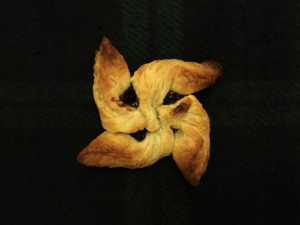Stella Santa
 | |
| Type | Pastry |
|---|---|
| Place of origin | Kingdom of Baia |
| Region or state | Castadilla |
| Created by | Edmond Cavreau |
| Invented | 1860 |
| Main ingredients | Wheat flour, butter, milk, eggs, yeast |
| Ingredients generally used | Various jams, various creams, molten chocolate |
Stella Santa (Pelaxian: Estrela Santa) is a traditional Castadillaan pastry that is typically made during the holiday season and especially during Docetempo ("Twelvetide"), but has also been known to have been consumed during major religious holidays throughout the year. Based upon the culinary traditions that have originated from Yonderre, it is made from yeast-leavened dough which had been shaped to resemble the shape of a star, with various jams most often being used for flavouring in the centre of the pastry.
Origins
Contrary to popular belief within Castadilla that claims that the Stella Santa has had a long history that dates as far back as the middle ages, the truth behind the pastry's origin is during the latter half of the 19th Century. During this time, there was a noted influx of Yonderian migrants, almost all of whom have since assimilated into the larger Delepasian culture. One of these migrants was a baker named Edmond Cavreau who was able to work his way towards becoming the head chef for the Baian royal family. As a surprise, Cavreau began to make a new pastry for the annual royal Baian Christmas ball in 1860. Taking inspiration from the Star of Bethlehem star in the sky that was created to signify the birth of Christ, Cavreau made the pastry into a star shape. Initial attempts were made with the pastry closely resembling a more traditional star shape, but the uneven browning or premature toughening of the dough for each attempt has led to Cavreau ultimately settling for the iconic wavy look that the pastry is famed for to this day.